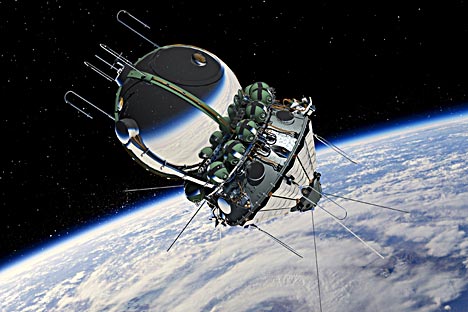
Skanex has the ability to provide regular observation of Russia’s territory and the CIS countries in real time with high spatial resolution. Source: Lori / Legion Media
Vladimir Putin’s former sparring partner, Arkady Rotenberg — now an influential businessman and billionaire — is investing in space technology. Business organizations under his control will invest about $28 million into Skanex.
As a result of this transaction, the businessman’s organization will receive 90 percent of shares, reports Kommersant newspaper, citing the Ministry of Economic Development as its source. Another 10 percent of the company will remain in the ownership of the founders of the Skanex, Vladimir and Olga Gershenson.
Skanex is one of the few high-tech businesses that have survived from the Soviet era, having been established in 1989. The company provides a broad range of high-tech services (ranging from reception to thematic processing of Earth from space) and also has the ability to provide regular observation of Russia’s territory and the CIS countries in real time with high spatial resolution.
In addition, Skanex owns a network of ground stations that receive data from satellites, and the company has gathered experts in the field of real-time satellite monitoring.
Skanex has created, maintained and developed departmental networks receiving ground stations — in particular, Rosgidromet and MChS. According to the information posted on the company’s website, being the operator of the commercial network stations UniScan in Russia, Skanex provides users with images from SPOT 5, SPOT 6, UK-DMC2, FORMOSAT-2, EROS A, EROS B and RADARSAT-1, online and from their own archives.
The company also has the exclusive rights to distribute the data from SPOT 4, SPOT 5, SPOT 6, SPOT 7, FORMOSAT-2, UK-DMC2, EROS A and EROS B in Russia.
The GIS market is actively developing and finding more and more industrial and consumer applications. "The development of technology significantly reduces the cost of access to information, which was previously the prerogative of public services and large corporations. At the moment, there are a number of projects in this area — including the Russian participants — so that, in the future, we can expect a redistribution of power," FCG partner Nicholas Lehmann told RBTH.
State safeguards IT sector against foreign takeover
A satellite image of an area of 1 square kilometer costs 60–600 rubles ($2–20) on the market, and the minimum quantity purchased is 100 square kilometers (nearly 40 square miles), Olga Gershenson, vice president of Skanex, told the media recently.
Eighty percent of Skanex contracts are government ones. The biggest of these is the Rosreestr contract for the supply of high-resolution satellite images for the cartographic base of the government real-estate cadaster. Skanex won the Rosreestr bid for 1.3 billion rubles ($40.9 million) back in 2011.
In the same year, it began its cooperation with Russia's largest Internet search engine, Yandex, which provides maps of the Earth's surface in high resolution.
This relationship with the real-estate cadaster was able to interest such a large and influential businessman as Arkady Rotenberg. In early October 2013, the Russian government approved the federal target program "Development of a unified state system of registration of the real-estate cadaster" for the period of 2014–2019.
The volume of its financing should reach 54 billion rubles ($1.7 billion). Skanex has a good chance of competing in the bid for participation in the project, according to FCG partner Alexander Minkin. "Mr. Rothenberg set his sights on the money," said IFH FIBO Group analyst Vasily Yakimkin.
Under the federal target program, by January 1, 2017, all subjects of the Russian Federation will move to a single open geocentric coordinate system, which will increase the accuracy of the state real-estate cadaster, reduce the time of state registration of rights and cadastral registration (up to seven and five days, respectively), and increase the share of public services provided in electronic form to at least 70 percent of the total volume.
Nevertheless, Skanex’s financial performance is quite good. In 2010, the company's revenue doubled to 925 million rubles. The following year, it increased by another quarter, up to 1.16 billion. The data for 2012 is not publicly available.
"If the balance sheet structure has not undergone significant changes since the end of 2011, we estimate that the value of 100 percent of the share capital may amount to 850-950 million rubles. Thus, the cost of 90 percent could be 765-855 million rubles," said Minkin.
According to Yakimkin’s estimates, 90 percent of the company’s shares could cost Arkady Rotenberg’s organizations 900 million rubles. Skanex declined to comment on pending transactions.
All rights reserved by Rossiyskaya Gazeta.
Subscribe
to our newsletter!
Get the week's best stories straight to your inbox